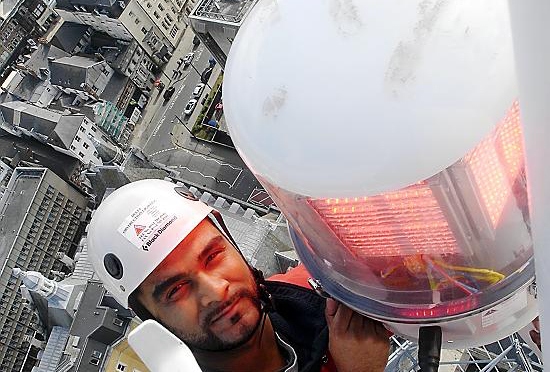Expert in warning on fake flight-path lights
Date published: 17 January 2013

LIGHTING expert Tariq Mukhtar with one of the warning lights
Illegal cost cutting by some operators is putting lives at risk — because it means tall cranes aren’t sufficiently visible to low–flying aircraft, it has been claimed.
Under aviation rules, specially designed bright red warning lights must be attached to tall structures on flight paths or near aerodromes.
But some operators use fake warning lights, with ordinary lights under red glass says Oldham-based lighting expert Tariq Mukhtar.
Tariq, technical director of Delta Obstruction Lighting Ltd, said: “Sometimes a company takes a short cut by putting an ordinary bulkhead light on a tall crane with a red cover surrounding it.
“It used to happen quite a lot. Since we’ve been educating the companies they have been behaving themselves better, but there are still some who do this.
He made his claim after yesterday’s horrific London helcopter crash, which killed the pilot and a man on the ground when a chopper hit a crane in heavy fog.
Though there is no suggestion the crane in the incident was improperly lit, the allegation raises a wider safety issue
“Aircraft warning lights are quite expensive, but that’s no excuse. It’s illegal and the consequences of using a hand–made warning light could be an incident like this.
“We go to a lot of sites to do inspections and that’s how we’ve been made aware of this. Usually when we put in a report pointing out that a company is not complying with the regulations, they put it right.”
In 2007, Delta Obstruction Lighting warned the construction industry that 80 per cent of all cranes in the vicinity of Britain’s major airports were not adequately lit. The situation is said to have improved greatly since.
Any structure over 45 metres tall on a flight path or near an aerodrome must be fitted with a medium intensity warning light. Similarly located structures under 45 metres tall may require a low-intensity light. Either must be red. The lights - much brighter than ordinary lights - have sensors which start them automatically in fog or darkness.
“These lights should easily be visible through fog,” said Mr Mukhtar.
Most Viewed News Stories
- 1New nursery moving into basement of old people’s home
- 2Councillor challenges village post box issues
- 3‘Completely inappropriate’ caravan park plans rejected
- 4Six arrests secured as police Operation Vulcan drive continues to tackle drug importation in Derker...
- 5Major rule changes beckon for bus pass holders




